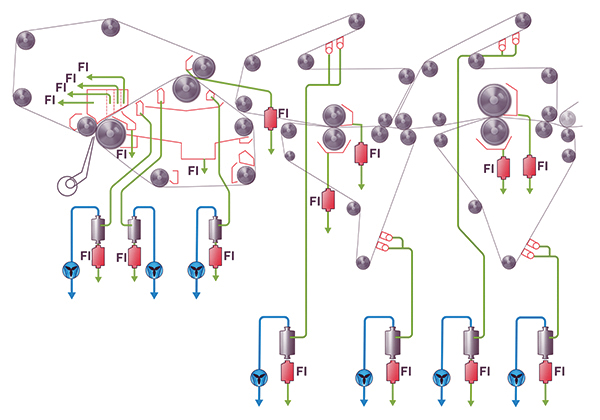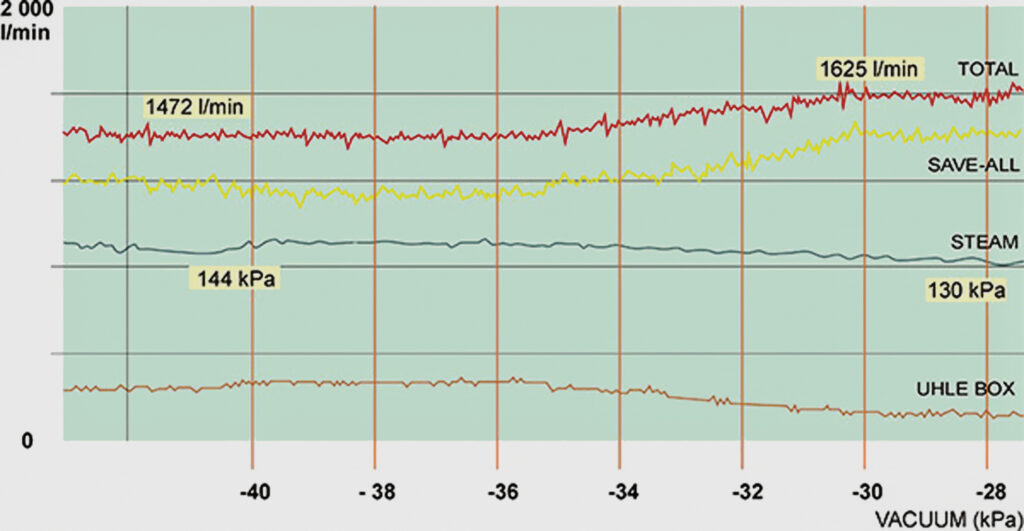JUSSI LAHTINEN
As industry understanding of dewatering has advanced, it has deepened the realization that the vacuum system should be flexible. Paper machine conditions change all the time. For example, machine speed can easily vary from 200 to 1,100 m/min, depending on basis weight and furnish; felt condition will change over its lifetime; and it’s not optimal to have the same amount of vacuum (-kPa and/or air flow) for different conditions. At Runtech Systems, more than 30 years of experience tells us it is very important to be able to measure water removal (Fig. 1) and control the vacuum levels.
We developed the Ecoflow dewatering measurement system as a tool for understand forming and press section dewatering and to show papermakers that it is possible to improve total dewatering by reducing Uhle box vacuums. We installed the first Ecoflows in the early 1990s, long before the nip dewatering trend started. Now more than 600 machines have been equipped with the Ecoflow system.

Traditional vacuum technologies were not good if the target was to optimize vacuum levels, minimize power consumption, and adapt to the changing conditions. One very big challenge has always been on new machines, where machine suppliers play on the safe side and vacuum specifications are often oversized. If the machine is delivered with an unsuitable type of vacuum equipment, the end customer must live with that.
As an example, Runtech has rebuilt 3- to 4-year-old vacuum systems reaching energy savings of more than 50 percent, or over 10 GWh/year. Unless vacuum systems are specified to machine supplier, they will often deliver the lowest cost option in terms of purchase price, not considering the life-cycle costs.
Runtech’s target has been to make a dry vacuum system with variable capacity (air flow) and then make it possible for the machine operator to select vacuum levels based on the actual need. So what defines the need?

In the case of flat boxes and Uhle boxes it’s most probably the water removal based on Ecoflows. For pick-up rolls it’s typically runnability. In the case of press suction rolls it can be both runnability and dewatering. In many cases a mill will want to have a slightly higher vacuum for the PU rolls when they pick up the sheet, but after that the vacuum level can be reduced. This will give a big energy saving and can be automated as well. But if your mill has runnability problems with the PU felt, you can easily ramp up the PU roll vacuums; the same goes with press suction roll vacuums (Fig. 2).
Typically, machine suppliers specify -65 kPa (19” HgV) vacuums for press suction rolls, but in many cases, this high vacuum is not needed. Typically for machines running less than 1,000 m/min, 40 or 45 kPa is enough for the press suction roll. This difference is easily US$122,000 per year. An easy way to find the correct vacuum level is the online dewatering measurement system.
Runtech Turbo Blowers provide variable speed and capacity. The integrated high-speed motor makes the system compact and easy to install. In most cases, Runtech can replace the existing system with minimum piping and civil work costs. A big part of the installation is done during the normal machine run and only a short shutdown is needed for the final connections. The latest new machine projects in Europe are Propapier PM 3, Hamburger Spremberg PM 2, Palm Aalen PM 5, and Mondi Ruzomberok PM 19.

In normal rebuild cases, the energy savings is 40-60 percent compared to the old system. One very good example is DS Smith Kemsley PM 6, where the existing vacuum system was replaced by four Runtech Turbos for energy savings of 50 percent. Production Manager Stuart Ruck reports that the new vacuum system allows them to start up the felts in the optimal way and this has shortened the PU felt start-up period to eight hours. This, of course, is extra production.
MISSION TO SHUT DOWN UHLE BOXES
Forming/press section dewatering and doctoring are a big part of our energy saving solution. Water is removed in two places: nips and Uhle boxes. If press roll doctoring is not perfect, Uhle boxes are needed. Runtech aims to build doctoring so that, with the correct felts, customers can close the Uhle boxes. You need to be able to see the situation without Uhle boxes, otherwise you just focus on the existing water amounts. Once again, good doctoring is designed to work together with the Ecoflows.
Especially for slow machines (< 600 m/min or 1970 fpm), it is critical to design the doctoring correctly because roll centrifugal force and water kinetic energy are low. Fast-running machines are easier, because water flies out from the press rolls automatically. Several of Runtech’s customers are now running without Uhle boxes, even though machine speeds with heavier basis weights are < 300 m/min (985 fpm).
One very good example of this type of optimization is at Smurfit Kappa’s Ania mill in Italy. Both PM 2 and PM 3 have been rebuilt and total energy saving in the vacuum system alone is 9 GWh/year, which equals US$856,000 annual electricity saving. Additionally, production increased by 2 percent, so payback time was about one year. Mill Manager Massimiliano Listi was shocked to learn how much vacuum they were using for nothing. For example, the suction couch roll vacuum was stopped after forming section optimization. Ecoflows provide a window to the process.
WHY IS NIP DEWATERING SO IMPORTANT FOR MACHINES PRODUCING BROWN PAPERS?
Brown paper machine production per meter width is normally fairly high. The most efficient machines are producing over 12 t/meter and this is very demanding for press section doctoring and water handling. High Uhle box dewatering would require a lot of Uhle box and vacuum capacity, so this would not make much sense economically. Typically, 20 to 40 kW/ meters (vacuum + press drives) are needed to run one Uhle box, so it makes a lot of sense to close unnecessary boxes. On top of energy saving, nip dewatering is also a very good way to improve total dewatering, reduce steam consumption, keep the felts open, and improve cross machine profiles (Fig. 3).
THE ROLE OF FELTS
Felts can make a big difference in total dewatering and dryness after press. It’s important to keep in mind that nip dewatering is not possible without perfect doctoring. Up to 3-4 percent improvement in press dryness is possible when customers have optimized their felts.
Heavy woven felts can be difficult to saturate to the right level, especially if the Uhle box vacuum is not controlled. It can be a challenge to keep high void volume felts open and in good condition if relayed on Uhle box dewatering. Typically, with modern nip dewatering, felts will give more stable dewatering conditions throughout the felt life and also facilitate faster start-up.
TOWARD A SMALLER CARBON FOOTPRINT
Runtech considers energy saving projects as bigger packages; it’s not only the vacuum pump or Turbo Blower in the basement. The target is to understand what happens on the machine levels and what might be wrong or different on the paper machine. During machine audits, Runtech can study:
• Vacuum systems
• Press section doctoring
• Vacuum piping for possible pressure losses
• Forming and press section doctoring/water removal
• Forming and press section showers
• Dryer section exhaust system and heat recovery
Combining Ecoflows, press section doctoring, and heat recovery to the vacuum system rebuild project will probably shorten the payback time significantly. Many companies have committed to reducing their CO2 emissions before 2030; vacuum system optimization projects are a very efficient way to reach these targets.
Jussi Lahtinen is sales director for EMEIA and Americas for Runtech Systems, part of Ingersoll Rand. Focused on the pulp and paper industry, Runtech Systems provides vacuum systems, heat recovery, doctoring systems, and water removal, as well as runnability and tail threading products.
 Paper 360
Paper 360